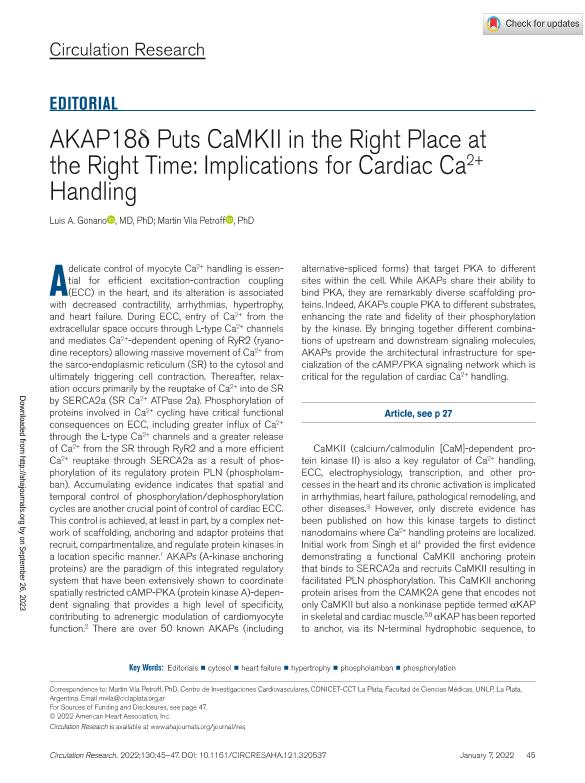Artículo
AKAP18δ Puts CaMKII in the Right Place at the Right Time: Implications for Cardiac Ca 2+ Handling
Fecha de publicación:
01/2022
Editorial:
Lippincott Williams
Revista:
Circulation Research
ISSN:
0009-7330
Idioma:
Inglés
Tipo de recurso:
Artículo publicado
Clasificación temática:
Resumen
A delicate control of myocyte Ca2+ handling is essential for efficient excitation-contraction coupling (ECC) in the heart, and its alteration is associated with decreased contractility, arrhythmias, hypertrophy, and heart failure. During ECC, entry of Ca2+ from the extracellular space occurs through L-type Ca2+ channels and mediates Ca2+-dependent opening of RyR2 (ryanodine receptors) allowing massive movement of Ca2+ from the sarco-endoplasmic reticulum (SR) to the cytosol and ultimately triggering cell contraction. Thereafter, relaxation occurs primarily by the reuptake of Ca2+ into de SR by SERCA2a (SR Ca2+ ATPase 2a). Phosphorylation of proteins involved in Ca2+ cycling have critical functional consequences on ECC, including greater influx of Ca2+ through the L-type Ca2+ channels and a greater release of Ca2+ from the SR through RyR2 and a more efficient Ca2+ reuptake through SERCA2a as a result of phosphorylation of its regulatory protein PLN (phospholamban). Accumulating evidence indicates that spatial and temporal control of phosphorylation/dephosphorylation cycles are another crucial point of control of cardiac ECC. This control is achieved, at least in part, by a complex network of scaffolding, anchoring and adaptor proteins that recruit, compartmentalize, and regulate protein kinases in a location specific manner.1 AKAPs (A-kinase anchoring proteins) are the paradigm of this integrated regulatory system that have been extensively shown to coordinate spatially restricted cAMP-PKA (protein kinase A)-dependent signaling that provides a high level of specificity, contributing to adrenergic modulation of cardiomyocyte function.2 There are over 50 known AKAPs (including alternative-spliced forms) that target PKA to different sites within the cell. While AKAPs share their ability to bind PKA, they are remarkably diverse scaffolding proteins. Indeed, AKAPs couple PKA to different substrates, enhancing the rate and fidelity of their phosphorylation by the kinase. By bringing together different combinations of upstream and downstream signaling molecules, AKAPs provide the architectural infrastructure for specialization of the cAMP/PKA signaling network which is critical for the regulation of cardiac Ca2+ handling.
Palabras clave:
CYTOSOL
,
EDITORIALS
,
HEART FAILURE
,
HYPERTROPHY
,
PHOSPHOLAMBAN
,
PHOSPHORYLATION
Archivos asociados
Licencia
Identificadores
Colecciones
Articulos(CIC)
Articulos de CENTRO DE INVEST.CARDIOVASCULARES (I)
Articulos de CENTRO DE INVEST.CARDIOVASCULARES (I)
Citación
Gonano, Luis Alberto; Vila Petroff, Martin Gerarde; AKAP18δ Puts CaMKII in the Right Place at the Right Time: Implications for Cardiac Ca 2+ Handling; Lippincott Williams; Circulation Research; 130; 1; 1-2022; 45-47
Compartir
Altmétricas




